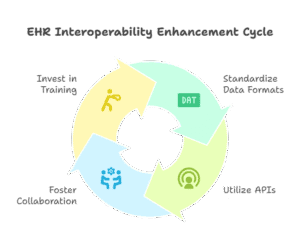On-Demand Outsourcing BPO Services for Healthcare Providers With 24/7 Coverage!
Save up to 70% on staffing costs!
Browse Specialty Staffing ServicesSolving EHR Interoperability Issues in Hospitals

Electronic Health Records (EHRs) have transformed modern healthcare by digitizing patient data, streamlining documentation, and improving access to medical information. Yet, despite their widespread adoption, many hospitals continue to struggle with EHR interoperability the ability of different systems to exchange, interpret, and use patient data seamlessly. Poor interoperability can lead to fragmented care, redundant testing, medical errors, and administrative inefficiencies. Solving this challenge is critical for improving patient safety, clinician efficiency, and healthcare system sustainability.
Understanding the Interoperability Challenge
Hospitals often use multiple EHR vendors or legacy systems that don’t “talk” to each other. Even when hospitals adopt the same vendor, configuration differences can prevent data sharing. Key challenges include:
Proprietary Systems: Many EHR vendors use closed architectures that limit data exchange.
Data Format Inconsistencies: Lack of standardized coding and data structures (e.g., different lab result formats) creates compatibility issues.
Information Blocking: Some vendors and institutions restrict data sharing to protect competitive advantage.
Workflow Disruption: Even when data can be exchanged, poorly integrated systems force clinicians to duplicate work.
Privacy and Security Concerns: Sharing sensitive health data raises HIPAA compliance and cybersecurity challenges.
Regulatory and Standards Landscape
Over the last decade, U.S. healthcare regulations have increasingly prioritized interoperability. Key frameworks include:
HITECH Act: Accelerated EHR adoption and set the foundation for interoperability goals.
21st Century Cures Act: Enforces rules against information blocking and encourages standardized APIs for data sharing.
FHIR (Fast Healthcare Interoperability Resources): An emerging standard that allows systems to exchange data through modern, web-based APIs.
Despite these advances, adoption across hospitals remains uneven, and implementation can be resource-intensive.
Strategies to Solve EHR Interoperability in Hospitals

1. Adopt and Enforce Data Standards
Hospitals should commit to industry-recognized standards such as HL7 and FHIR. This ensures structured and coded data (like lab results, medication lists, and allergies) can be shared consistently across systems.
2. Leverage Health Information Exchanges (HIEs)
Participation in regional or national HIEs allows hospitals to share patient information securely across different providers, pharmacies, and payers. HIEs can reduce duplicate testing, improve emergency care, and enhance care coordination.
3. Implement Open APIs
Modern EHRs should be equipped with open APIs that allow for smooth integration with third-party applications, decision-support tools, and other hospital systems. This supports innovation while reducing silos.
4. Invest in Middleware Solutions
Middleware acts as a bridge between disparate systems, standardizing data and enabling cross-platform communication without replacing existing EHRs. This can be a cost-effective solution for hospitals with multiple legacy systems.
5. Enhance Vendor Collaboration and Accountability
Hospitals should hold vendors accountable by including interoperability requirements in contracts. Vendors should also be encouraged to participate in industry consortiums to align on standards and best practices.
6. Focus on Clinical Workflow Integration
Solving interoperability isn’t just about exchanging data—it’s about making it usable at the point of care. Hospitals must design workflows that integrate external data seamlessly into EHR dashboards, reducing physician burden rather than adding clicks.
7. Address Privacy and Security Proactively
Robust encryption, role-based access, and compliance monitoring are essential to build trust in interoperable systems. Hospitals must balance seamless data flow with stringent HIPAA compliance.
8. Encourage Patient-Centered Interoperability
Patients should have access to and control over their health information across providers. Tools like patient portals and mobile health apps (powered by FHIR) enable patients to consolidate their records and share them as needed.
Benefits of Improved Interoperability
Solving interoperability challenges provides hospitals with:
Better Care Coordination: Physicians access comprehensive patient histories in real time.
Reduced Costs: Eliminating duplicate tests and procedures lowers operational costs.
Fewer Medical Errors: Complete, accurate data reduces prescribing errors and misdiagnoses.
Enhanced Patient Experience: Patients avoid repeating histories and benefit from more personalized care.
Improved Public Health Insights: Aggregated interoperable data supports research, population health, and pandemic response.
Future Outlook
EHR interoperability is progressing, but slowly. With advancements in cloud-based EHRs, AI-driven integration tools, and government enforcement of interoperability rules, hospitals will increasingly be able to overcome historical silos. The ultimate goal is a connected healthcare ecosystem where data flows securely, efficiently, and meaningfully—supporting both providers and patients.
What Did We Learn?
Hospitals cannot achieve value-based care, efficient operations, or optimal patient safety without tackling EHR interoperability. By adopting standards like FHIR, leveraging HIEs, implementing open APIs, and aligning workflows, hospitals can break down silos and create a truly integrated healthcare system. The path forward requires collaboration among hospitals, vendors, regulators, and patients, but the benefits better outcomes, reduced costs, and improved patient trust make the effort indispensable.
What People Are Asking?
1. What is EHR interoperability?
It is the ability of different EHR systems to exchange, interpret, and use patient data seamlessly.
2. Why is interoperability important for hospitals?
It improves care coordination, reduces duplicate tests, lowers costs, and enhances patient safety.
3. What are the main barriers to interoperability?
Proprietary systems, inconsistent data formats, workflow disruptions, and privacy/security concerns.
4. How can hospitals improve interoperability?
By adopting standards like FHIR, using HIEs, implementing open APIs, and integrating workflows.
5. What role do patients play in interoperability?
Patients benefit from access to their records across providers and can share their data through portals and apps.
Disclaimer
For informational purposes only; not applicable to specific situations.
For tailored support and professional services,
Please contact Staffingly, Inc. at (800) 489-5877
Email : support@staffingly.com.
About This Blog : This Blog is brought to you by Staffingly, Inc., a trusted name in healthcare outsourcing. The team of skilled healthcare specialists and content creators is dedicated to improving the quality and efficiency of healthcare services. The team passionate about sharing knowledge through insightful articles, blogs, and other educational resources.
 Book a Demo to Build Your Team Today!
Book a Demo to Build Your Team Today!

 Read Case Studies
Read Case Studies 


 Virtual Medical Assistants
Virtual Medical Assistants



